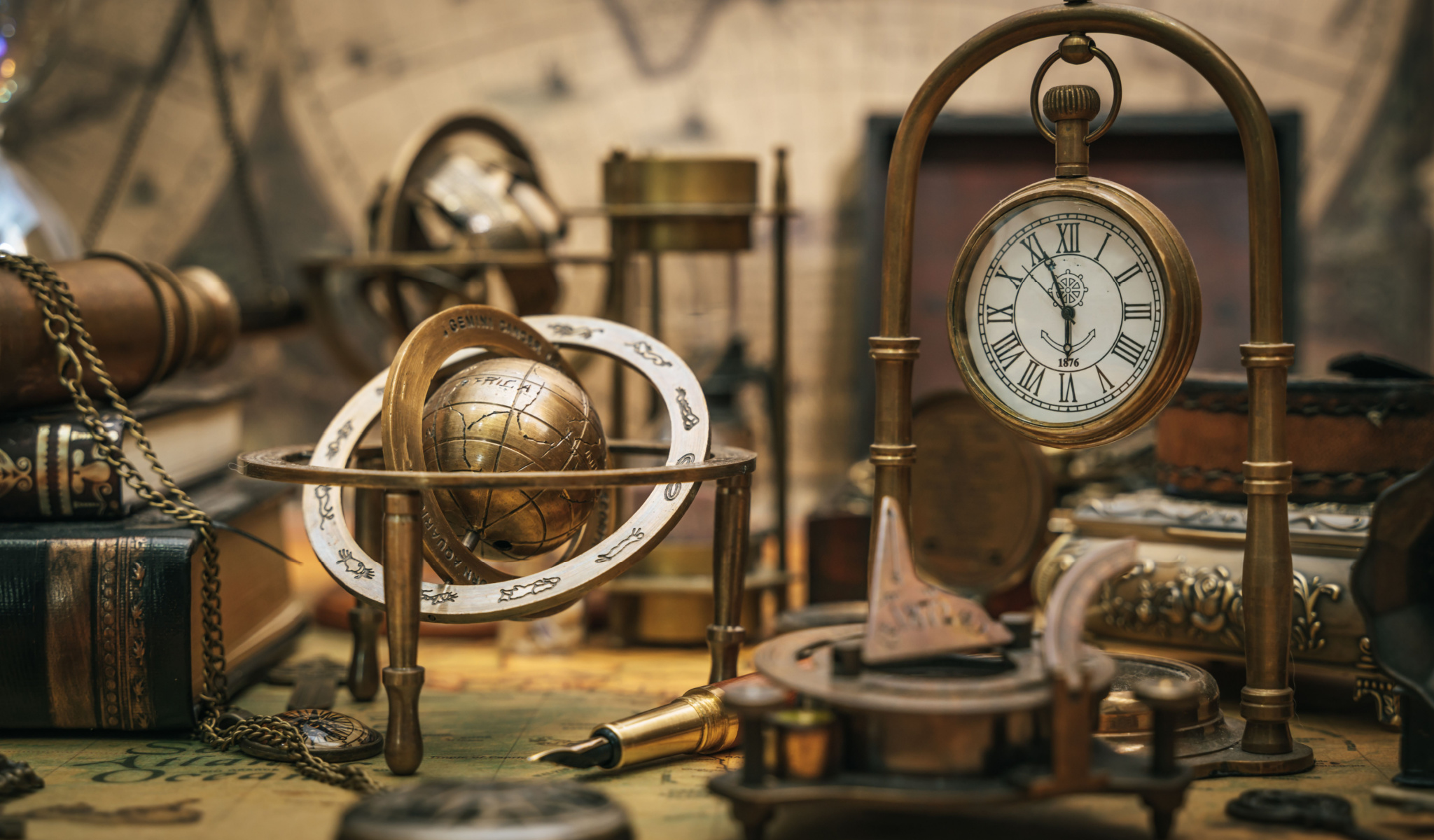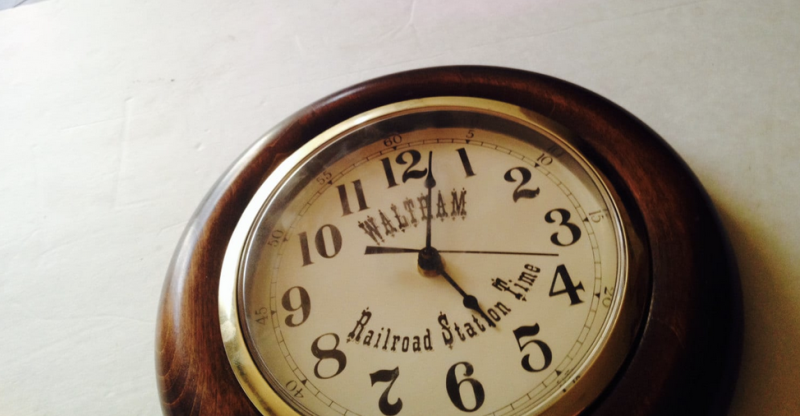
An intriguing controversy hit much of the civilized planet in the second half of the 19th century. How would we tell what time it is? For the whole of human history, this was not a problem. Schedules were coordinated based on the position of the sun. With the invention of the sundial – sometime around 1500 BC and used commonly until relatively recently – mankind knew that having the sun overhead meant it was midday.
The face of the medieval clock with mechanical levers, ticks, and gongs was nothing but an extension of the sundial, except that you could tell the time even if the sun was not out. That’s rather helpful and one can see how it caught on. The city hall and the main churches in every town would sound the time for the whole community.
By the mid and late 19th century, each household started acquiring clocks. It was a huge business and involved traveling salesmen. Clock makers (and repairmen) formed the industrial backbone of many cities in Europe, UK, and the US. They were forever improving, and that helped with work schedules and time sheets at the office. The whole industrialized world became governed by time and with greater precision than had ever been possible.
So far so good. But then came the railroads. You see, until then, of course, every town possessed its own understanding of what time it is. It was a different time in New York City than it was in Brooklyn or Long Island or Newark. This was true all over the world. Every community had its own time. That’s because the sun hits the moving earth at a different moment in every square inch of the planet.
As Wolfgang Schivelbusch (1977) describes it: “London time ran four minutes ahead of time in Reading, seven minutes and thirty seconds ahead of Cirencester time, fourteen minutes ahead of Bridgwater time. This patchwork of varying local times was no problem as long as traffic between the places was so slow that the slight temporal differences really did not matter; but the temporal foreshortening of the distances that was effected by the trains forced the differing local times to confront each other.”
There we have it: the trains! They shortened space and time in amazing ways. This is simply because they ran faster than the sun was rotating around the earth, thus giving rise to every manner of philosophical reflections on the meaning of geography itself. With the advance of railroad speeds, would the whole world become one big city? Would we even care where we live given that we can see so much of the world in all directions and even in one day?
In any case, all of this made life extremely difficult for trains to make schedules. After the trains began to run in the 1830s and faster and faster through the decades, you could arrive at a place not that far away and be there, according to the clock, before you left your origin city. This played havoc with coordination.
This was especially true in the US because there were so many competing lines of trains. They were in stiff competition so they also kept their own time schedules too. Mostly the railroad companies would settle on a single standard of time, usually wherever the headquarters of the company was, and just watch it pass and set arrival times based on that alone. This meant that departure and arrival times could be hours off from what was technically local time (or what is now called solar time).
Eventually, the companies agreed on standards. They would divide up geography according to large zones, regardless of the actual time. During the 1880s, this created enormous controversies for most of the general public and city fathers who were faced with pressure from industrial interests to adopt the new zones and dispense with local time. This was extremely annoying to just about everybody except those who took the trains all the time or were scheduled to meet someone at the station.
This did, however, create new opportunities for the clock industry. They started manufacturing large household clocks that would have one clock face for local time and another for what was called “Railroad Time.” So there was real time and industrial time. That seems easy enough but the solution did not last. As city managers were very much of the desire to court the railroad industrialists, they were keen to dragoon the entire population into accepting the new “modern” ways and letting go of their old systems of timekeeping that were in keeping with nature.

So you had an odd situation. Someone would say “It’s 11am” but you look overhead or at your sundial or at your actual clock and you see that it is midday noon. All things lined up to say it is noon. And yet here stands this Thoroughly Modern Millie telling you something that is obviously completely untrue and yet insisting that it is true.
Thus began for many the detachment between technological truth and actual truth. And this was not a small issue. Time is everything. It’s when you go to work, when you take a break, when you eat, when you go to bed and when you rise to meet the day. Here we have some technologically informed experts telling you that something is the case that clearly is not the case because their truth contradicts the way we’ve determined the time for 3,500 years!
So yes, there was a massive political struggle in every town and city in the country over this issue. Rightly so. All of this came to a head in 1889 when the railroads, many of which were by now government-backed monopolies, officially agreed on four time zones. In 1918, the time zones were all given legal recognition by the federal government, according to Schivelbusch (The Railway Journey, University of California Press, 1977).
Might there have been a more elegant solution? It’s very obvious: one universal time for the world (Greenwich Mean Time) which could be called schedule time, and then all actual real-world local times could go on as always. The idea of zones is a confusing and half-baked solution – cobble together to pretend what is not real is real – and made even worse by the absurdities of Daylight Savings Time.
Oddly, we seem headed in this direction now in any case, since GMT is ever more used to schedule meetings around the world. The time zone bit, however, still sticks.
So, you see, it could all have been achieved without imposition, upheaval, and industrial hegemony over nature and tradition. There was no reason for intimidation, compulsion, and time imperialism. It could have been completely voluntary and completely rational, without any social conflict at all.
We read about this history and wonder where we would have been on this great struggle. The romantic in me likes to believe that I would have resisted the change and stuck to reality. The techno-enthusiast in me suspects I would have rallied behind the ambitions of the railroad company.
Still, something about the way it ended up makes me sad. Not one in 10 million people can read a sundial today, knows the origin of the clock face, or knows that noon once meant sun overhead. For that matter, fewer and fewer people today can even tell time!
I was once party to a discussion between a man, who was doing a lot of TV interviews in China, and his wife. He pointed out that he had to get back to the house to be at the studio since in China it is already tomorrow.
“That’s really neat that you can broadcast from today into tomorrow,” she said in all seriousness.
He gently pointed out that only the definition of time changes, not time itself, since what we call “now” is the same everywhere. She was seriously confused by that point. There would never be such confusion if we had stuck with local time (solar time) and GMT.
Our sense of reality has never been more detached from reality itself. We experience it constantly online but also even with little things like the weather. Is it cold outside? I don’t know, let me pull up my app connected to my smart device which is connected to the Internet which travels down fiber lines and exchanges information with a cell tower that broadcasts information from thousands of miles away. Of course I could put a thermometer actually outside and look but that would be too much trouble.
Making it all even more preposterous, we are supposed to trust only the technically employed climatologists – not our own eyes and experience – to tell us the present and future of the climate itself, which they unveil at international conferences and complicated academic papers in prestigious journals. Just trust them!
Those who live virtually have lost contact with those who do not. It was so bad only four years ago that “knowledge workers” decided to close the whole world and lounge in PJs and stream movies while expecting random non-persons to deliver them groceries and supplies, not for two weeks but for two years, with nary a thought about who these people are or whether they might catch the bad virus hanging around.
We’ve become so detached from physical reality that many people don’t even think their own bodies are determinative of their health, physical or mental. I’m sick. Here’s a pill. I’m sad. Here’s a pill. I want muscles. Take this drug. I’m fat. Here’s a pill. There’s a virus. Take this shot, twice, three times, even seven times. I got sick anyway. Take another pill. It’s expensive. Put it on your insurance for which someone else pays. I got the bug again. Take another pill.
So on it goes, as if physical reality and nature don’t even exist or that it can all be overcome with some new medical technology which includes not only pharmaceuticals but endless and expensive therapies. For that matter, if we have access to it all, we can live forever. Just have to have the right combination of chemical stuff to make it possible. If that doesn’t work, freeze your head. We’ll get there eventually.
So, yes, every trend can be taken too far, but perhaps we should become more aware of how all this detachment from the world around us begins and be more skeptical. For my part, I would be happy knowing and following the actual local time again. Maybe we need sundials again. Our times are so rough, brutalized by a techno-fascist junta that forever wants to jab us and force us all into the metaverse, I’m finding the idea just a bit tempting.
P.S.: Oh wait: there is a website to tell you your actual local (solar) time! Thank you technology, I guess.
Disclaimer
Some of the posts we share are controversial and we do not necessarily agree with them in the whole extend. Sometimes we agree with the content or part of it but we do not agree with the narration or language. Nevertheless we find them somehow interesting, valuable and/or informative or we share them, because we strongly believe in freedom of speech, free press and journalism. We strongly encourage you to have a critical approach to all the content, do your own research and analysis to build your own opinion.
We would be glad to have your feedback.
Source: Brownstone Institute Read the original article here: https://brownstone.org/


